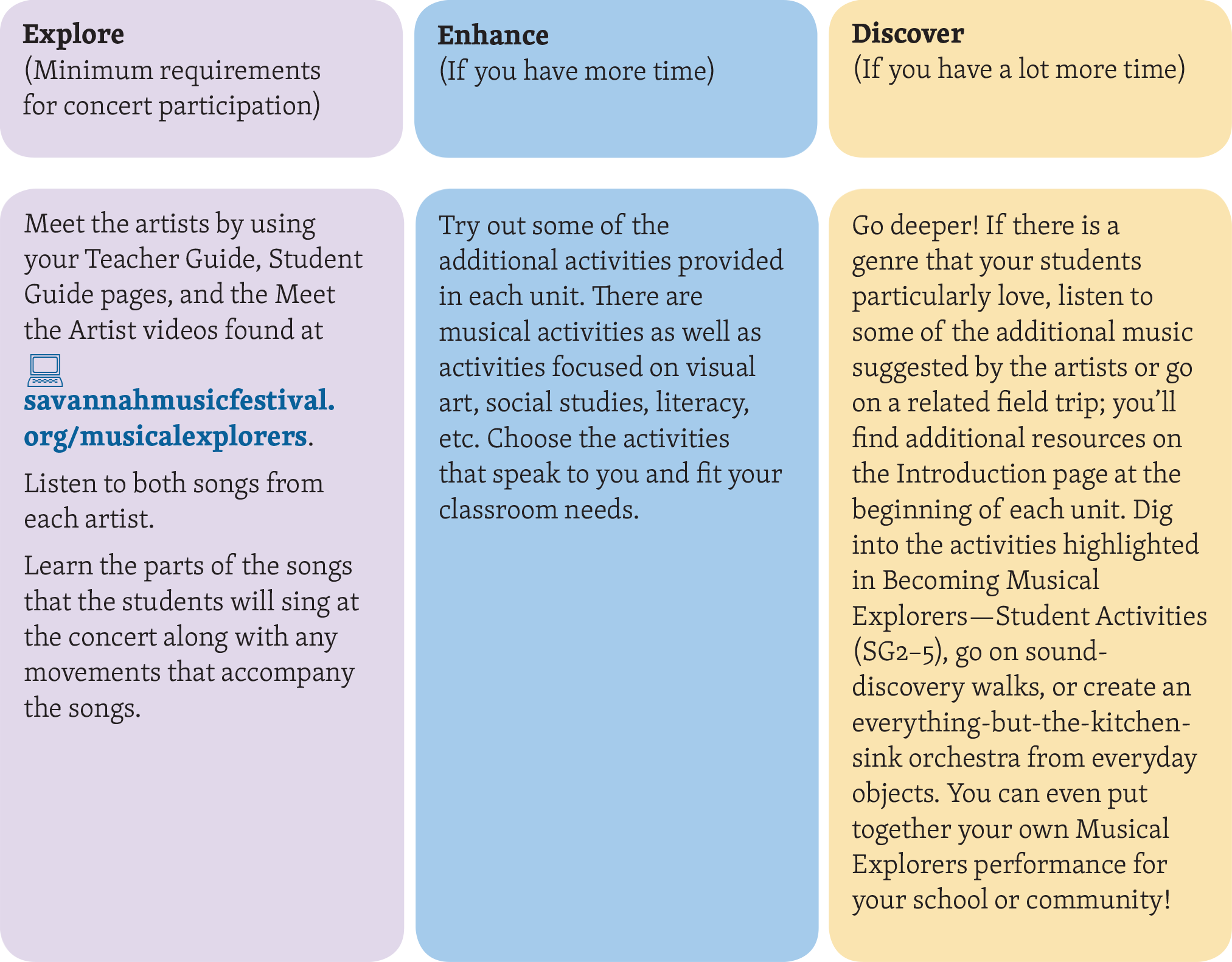How to Use the Teacher and Student Guides
This Teacher Guide contains six units, each devoted to one of our Musical Explorers genres. Every unit contains two lessons, each focusing on a song; the lessons guide you through the process of learning the songs, as well as teaching relevant musical concepts and exploring the cultural context of each genre. There are multiple activities within each lesson; you can choose among them to best suit the needs of your classroom. The complementary Student Guide (SG) pages are incorporated within the Teacher Guide. Families can continue the journey at home with the companion Family Resources.
Additional features that can be found within each lesson include:
- Audio Tracks: Audio tracks can be accessed on the accompanying CD, and are available online on each unit’s page online.
- Videos and other online resources: Introductory videos for the artists and their music and other online resources can be found on each unit’s page.
- Resources for Teachers: Each unit starts with a page of resources that provides background information about the musical genre and culture. Some of these resources are intended to be shared with students; others are for teachers who may want to explore further on their own.
- Creative Extensions: Creative extensions are designed to deepen the exploration of repertoire, culture, and musical concepts.
- Literacy Extensions: Each unit identifies picture books related to the artist’s music and culture that you can read with your students.
- Musical Word Wall: We encourage you to build a word wall and add vocabulary words as they are introduced in the lessons. A glossary of terms can be found in the back of this Teacher Guide.
Music Educator’s Toolbox
Carnegie Hall’s digital Music Educators Toolbox provides additional activities, worksheets, audio and video resources, and assessments to supplement your teaching. You can browse the Toolbox by grade level or concept, and all activities are tied to national music standards. These materials are free for use at carnegiehall.org/toolbox.
Options for Teachers of Students with Special Needs
- Students can participate in Musical Explorers in a variety of ways and may learn the songs by singing, moving, and/or clapping. You may also want to focus on smaller sections of the songs. Since you know your students best, allow them to participate in ways that will help them feel the most successful.
- Encourage students to engage with the music using tangible objects, such as handmade instruments (e.g., cups with beans for shakers), rhythm sticks, and drums.
- Allow time for students to experience the music and repeat as often as necessary. The lessons outlined in this curriculum may take additional time and span more than one class period. Use one-step directions and visuals as often as possible to help students understand the concepts.
- Some visual aids are provided within the curriculum and at the Musical Explorers concerts, but you may wish to provide additional resources to help your students engage with the material. If you have ideas for elements to include in future curricula, please send them to education@savannahmusicfestival.org.
Pathways for Teachers
There are three suggested pathways for teaching the Musical Explorers curriculum, depending on the age and level of your students and the amount of time you can dedicate to the program. Teachers may present the three units within each semester in any order that fits their curriculum.

Active Listening Tips
One of the goals of Musical Explorers is to develop habits of active and engaged listening. You can support your students on this journey by using the following strategies.
Make the Invisible Visible
Look for ways to make the invisible world of music visible and, whenever possible, kinesthetic. These methods include:
- counting, clapping, and tapping rhythms (body percussion)
- drawing or painting to music
- connecting the music to narrative ideas
- dancing and moving to music
- connecting cultural ideas with music
Ask Open-Ended Questions
Here are some general suggestions to inspire discussion as students encounter new songs and new sounds. We include additional scripted prompts in blue italics throughout the Teacher Guide as a starting point for further learning and exploration.
- What do you hear in this music?
- How would you move to this music?
- What words can you use to describe this music? For example, is it busy or calm, loud or soft, high or low, smooth or bumpy?
- How does this music make you feel?
- What do you think the musicians are feeling? What makes you think that?
- What are the instrumentalists doing? What is the singer doing?

